The fierce rear-guard action fought by 4th (Guards) Brigade’s (2nd Grenadier Guards, 2nd and 3rd Coldstream Guards and 1st Irish Guards) against the German III Corps in the Forest of Retz, to the north of Villers Cottérêts, leading to substantial casualties on each side
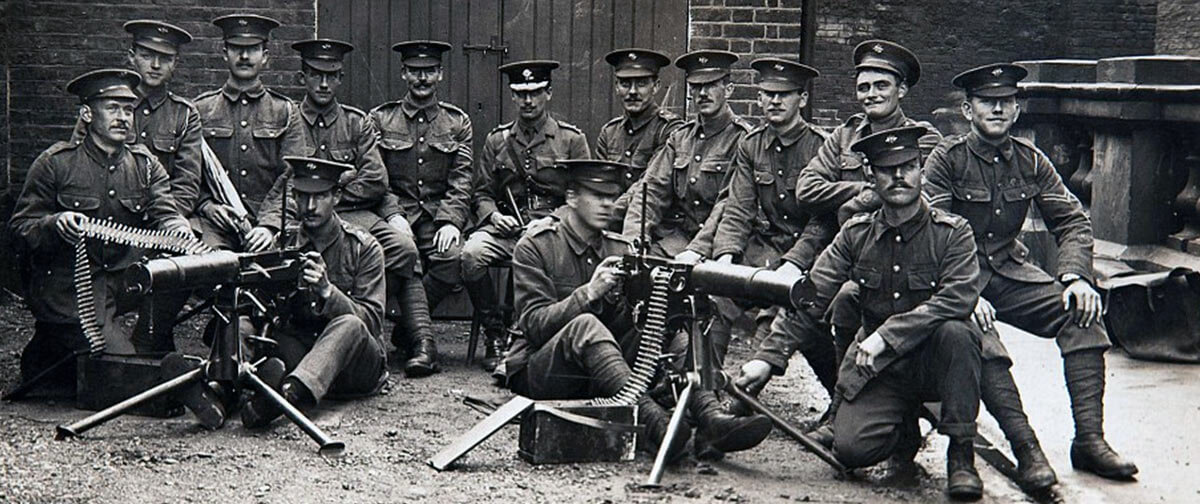
Irish Guards machine gun detachment At Wellington Barracks in August 1914 before leaving for France: Battle of Villers Cottérêts on 1st September 1914 in the First World War
The previous battle in the First World War is the Battle of Néry
The next battle in the First World War is the Battle of the Marne
Date of the Battle of Villers Cottérêts: 1st September 1914.
Place of the Battle of Villers Cottérêts: In the North of France
War: The First World War also known as ‘The Great War’.
Contestants at the Battle of Villers Cottérêts: 2nd Division of I Corps of the British Expeditionary Force (BEF): comprising 4th (Guards) Brigade and 5th and 6th Brigades, with supporting units of artillery (XLI RFA Brigade) and cavalry and 3rd and 5th Cavalry Brigades, against the German III Corps of General von Kluck’s First Army, comprising 5th and 6th Divisions.
Commanders at the Battle of Villers Cottérêts: Field Marshall Sir John French commanded the BEF. Lieutenant-General Sir Douglas Haig commanded I Corps. Major-General Monro commanded 2nd Division. Brigadier-General Scott-Kerr commanded 4th (Guards) Brigade, the main British formation committed to the fighting.
General von Lochow commanded the German III Corps.
Size of the Armies at the Battle of Villers Cottérêts: The British 2nd Division comprised around 18,000 men, 40 guns and 18 machine guns. 4th (Guards) Brigade comprised around 4,000 men and 8 machine guns. 9th and 17th Batteries RFA each comprised six 18 pounder field guns.
The German III Corps comprised around 35,000 men, 140 guns and 40 machine guns.
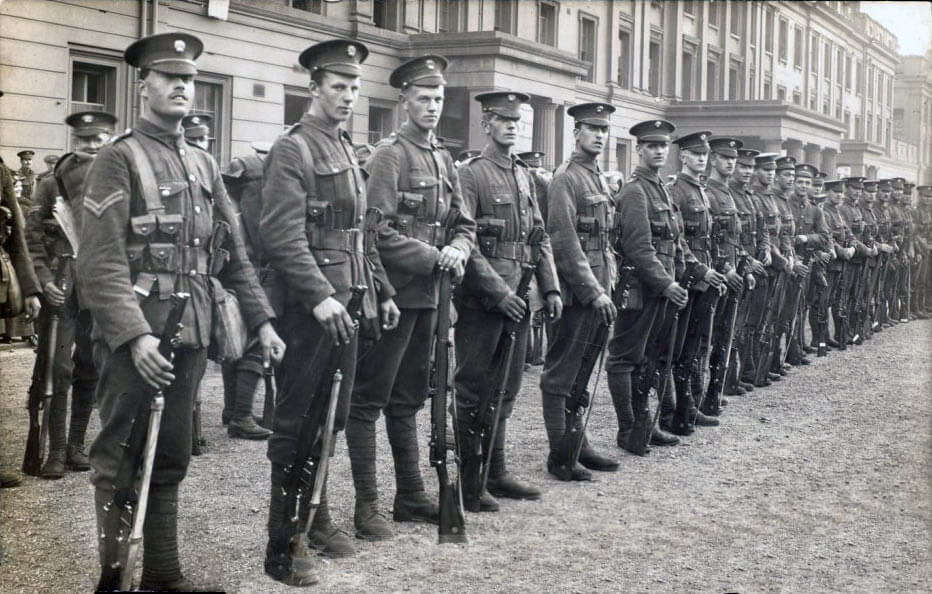
2nd Grenadier Guards parading at Wellington Barracks before leaving for France: Battle of Villers Cottérêts on 1st September 1914 in the First World War
Winner: During the battle, the British 4th (Guards) Brigade, with the rest of the 2nd Division, II Corps, was forced back through the forest into Villers Cottérêts, and compelled to continue the retreat, but heavy casualties were inflicted on the pursuing German III Corps and its pursuit delayed.
Uniforms and equipment at the Battle of Villers Cottérêts: See this entry on the ‘Battle of Mons’
Background to the Battle of Villers Cottérêts: See this entry on the ‘Battle of Mons’.
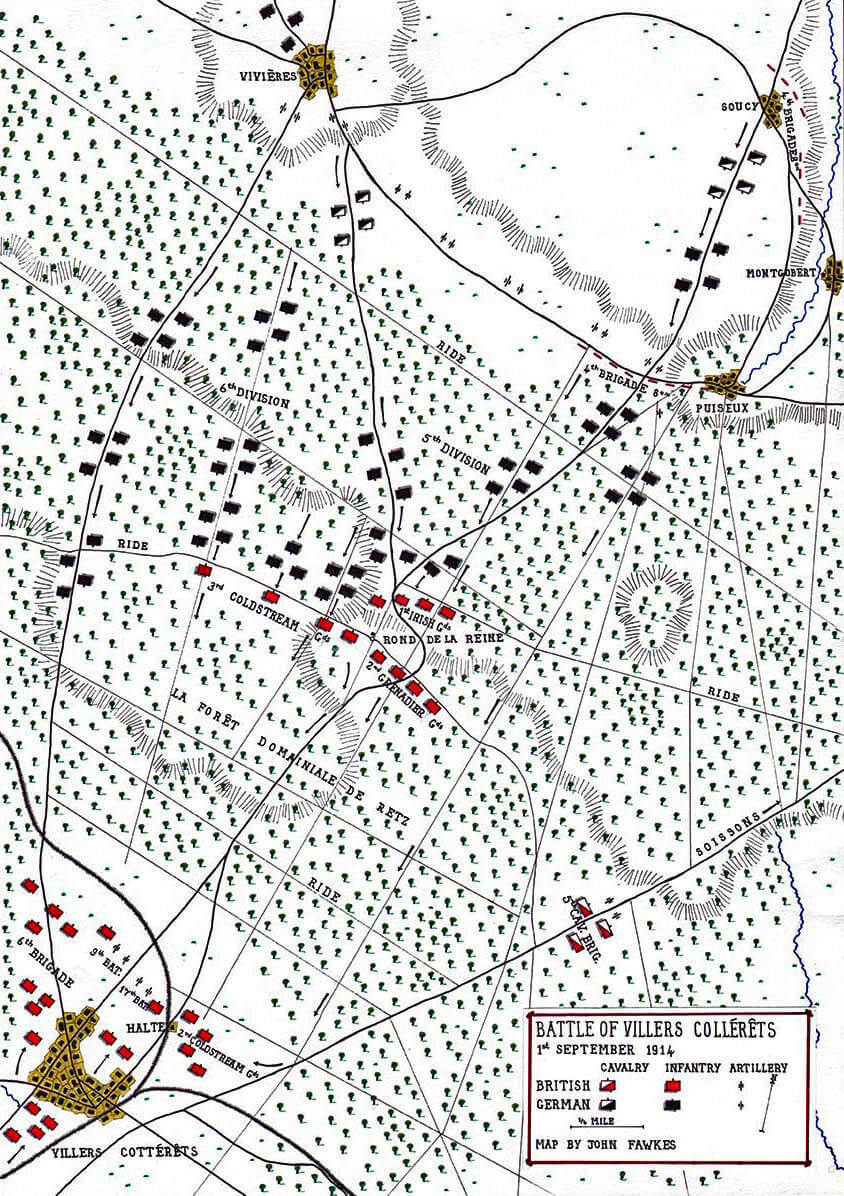
Map of the Battle of Villers Cottérêts on 1st September 1914 in the First World War: map by John Fawkes
Account of the Battle of Villers Cottérêts: As the BEF, with the French Fifth Army under General Lanrezac on its right, retreated before the German First and Second Armies (General von Kluck and General von Bülow), von Kluck ceased his advance to the south west and swung his First Army round to the south east, aiming at the left flank of the French Fifth Army.
Following the battle of Guise on 29th August 1914, after which the French Fifth Army of General Lanrezac pulled back towards the south east, the German High Command considered the French Fifth Army to have been defeated, and the BEF to be in a state of rout, and no longer a viable fighting entity. Von Kluck described these formations as a beaten and disorganised horde.
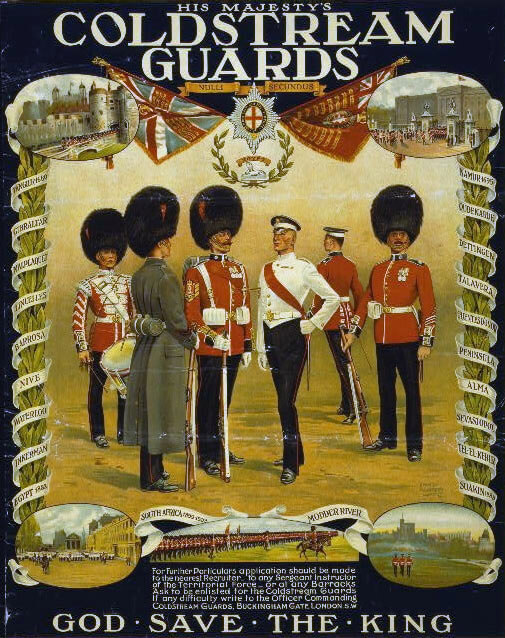
Coldstream Guards recruiting poster: Battle of Villers Cottérêts on 1st September 1914 in the First World War
The change of direction by von Kluck would, within a few days, give General Joffre his opportunity to launch the French 6th Army, under General Manoury, with the Paris garrison, under General Gallieni, from the west against von Kluck’s open right flank, in the battles of the Marne and the Aisne.
In the meantime, the BEF and the French armies continued to retreat towards the Marne River.
On 31st August 1914, the BEF’s alignment had I Corps to the south west of Soissons, II Corps to its west, the newly formed III Corps, comprising 4th Division and 19th Brigade, positioned along the Oise River at Verberie, and the brigades of the Cavalry Division dispersed along the line. 5th Cavalry Brigade guarded the eastern flank and 3rd Cavalry Brigade the western flank of I Corps.
On 1st September 1914, the BEF’s retreat was to be resumed before first light. The fighting that broke out around dawn, involving the British 1st Cavalry Brigade at the Battle of Néry, delayed the move for the whole BEF.
German attacks on units of the 5th Division (II Corps), in the area of Crépy, were halted by artillery fire and that Division did not move off until around 10am.
I Corps, accompanied by the 3rd and 5th Cavalry Brigades, resumed its march at 4am, passing through the Retz Forest (full name: ‘La Forêt Dominiale de Retz’) to Villers Cottérêts. The 1st Division marched down the east side of the Retz Forest, by the main road from Soissons, turning to the south east at Villers Cottérêts, in the direction of La Ferté Milon.
2nd Division took a more indirect route to Villers Cottérêts, through Vivières, which took it through the middle of the Retz Forest, coming into Villers Cottérêts from the north.
3rd Cavalry Brigade:
To the west of 2nd Division, at Taillefontaine, the British 3rd Cavalry Brigade (GOC: Brigadier-General Gough, with 4th (Queen’s Own) Hussars, 5th (Royal Irish) Lancers, 16th (The Queen’s) Lancers and 3rd Signal Troop) was attacked by the German 6th Division; the British 4th Hussars being engaged for most of the morning.
The 4th Hussars spent the night of 31st August in Roye St Nicholas. The regiment began the march at 4am on 1st September, passing through Mortefontaine, and halting at Taillefontaine, some 5 miles. At around 9am a large German force of cavalry, infantry and guns appeared from Roye St Nicholas and opened fire on the regiment’s A Squadron, although inflicting only slight casualties.
The 3rd Cavalry Brigade withdrew through the western part of the Retz Forest in a south westerly direction, towards Vez, where the brigade was to remain, to maintain contact between I and II Corps. A and C Squadrons, 4th Hussars, were left as a dismounted rear guard, holding a mile front in a ride in the forest. The order to the 4th Hussars was to remain in this position until 12.30pm.
At 12.30pm, as C Squadron was preparing to withdraw, the German infantry came through the dense undergrowth in force and attacked the 4th Hussars. The commanding officer of the 4th Hussars, Lieutenant-Colonel Hogg, was directing the withdrawal and was severely wounded. Left with the regiment’s medical officer and captured by the Germans, Colonel Hogg died 3 days later.
The 4th Hussars re-joined the brigade and marched south from Vez, arriving at Thury at 8pm, a distance of 12 miles.
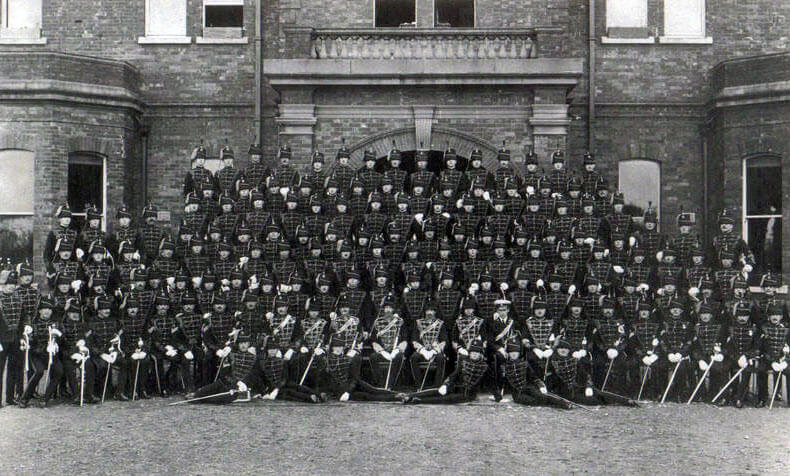
C Squadron, 4th (Queen’s Own) Hussars, in August 1914: Battle of Villers Cottérêts on 1st September 1914 in the First World War
4th (Guards) Brigade:
The 4th (Guards) Brigade of 2nd Division, I Corps, commanded by Brigadier-General Scott-Kerr, arrived in the area of Soucy, 5 miles to the north-east of Villers Cottérêts, on 31st August 1914. 5th Cavalry Brigade was in Montgobert, 1 mile to the south east of Soucy.
Under heavy pressure from the overwhelming number of Germans pressing through the wood, the 3 battalions of 4th Brigade fell back, south towards Villers Cottérêts.
At around midnight, the 4th Brigade was directed to form the rear-guard for I Corps, with 9th Battery from XLI Brigade RFA, and B Squadron, 15th Hussars, the Divisional Cavalry.
In accordance with this direction, 4th Brigade dug entrenched positions just north of Soucy, 3rd Coldstream on the left and 2nd Grenadiers on the right, with Number 4 Company, 2nd Grenadier Guards, detached to form a flank guard on the edge of the ravine above Montgobert. The other 2 battalions of the brigade, 1st Irish Guards and 2nd Coldstream, prepared positions to the rear, on the northern edge of the Retz Forest.
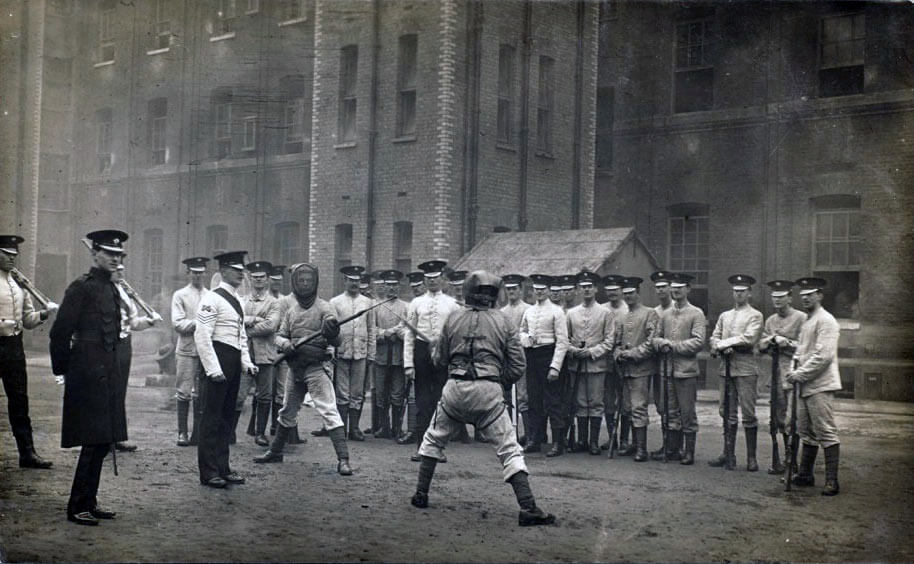
Irish Guards practising bayonet fighting at Wellington Barracks in 1914, before leaving for France: Battle of Villers Cottérêts on 1st September 1914 in the First World War
During the early hours of 1st September, the rest of 2nd Division marched through the 4th Brigade positions, taking the road through the forest to Villers Cottérêts.
During the morning of 1st September, the pursuing German formations, from 5th and 6th Divisions of General Lochow’s III Corps (General von Kluck’s First Army), appeared before the positions north of Soucy, and the 2 Guards battalions disengaged and withdrew to the south, following the road through the middle of the Retz Forest towards Villers Cottérêts, previously taken by the rest of 2nd Division.
During this disengagement, a cart drove up to the 3rd Coldstream’s position, apparently containing civilian refugees. The refugees suddenly fled the cart, from which a German machine gun opened fire at close quarters. The cart turned and made its escape. No casualties were caused.
The Retz Forest covers a large area around the north, east and south of Villers Cottérêts, and is divided up by a network of rides and some roads. The rides cross each other, with the major intersections called ‘Ronds’ or circles. 3 roads radiate from Villers Cottérêts, one heading roughly to the north (to Vivières), one to the north-north-east (to Soucy and Puiseux) and the third to the north east (to Soissons). The Soucy/Puiseux road runs through the middle of the forest. Halfway through the forest, the Soucy/Puiseux road kinks around a rond called ‘Le Rond de la Reine’. At this point one of the main forest rides runs west to east through Le Rond de la Reine. Some accounts take Le Rond de la Reine as the name of this ride.
It was in this area that the Battle of Villers Cottérêts was fought on 1st September 1914.
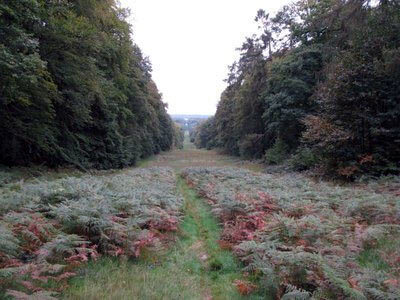
Ride in the Retz Forest at Villers Cottérêts: Battle of Villers Cottérêts on 1st September 1914 in the First World War
Neither the Germans nor the British were familiar with the forest. The Rides did not follow a strict pattern and this, with expanses of dense forest, created a confusing milieu in which to fight a close and intense battle, causing both sides difficulty. Sub-units became intermingled and lost, and, by the end of the battle, was marked by German units attacking each other in the forest.
After withdrawing from Soucy, 4th (Guards) Brigade took up position in the Retz Forest, covering the retreat of the rest of 2nd Division through Villers Cottérêts to the south. 1st Irish Guards and 2nd Coldstream Guards remained on the northern edge of the forest, under the command of Lieutenant-Colonel the Hon. George Morris of the Irish Guards; 1st Irish Guards on the Vivières side of the north-south road from Soucy to Villers Cottérêts and 2nd Coldstream on the Puiseux side of the road.
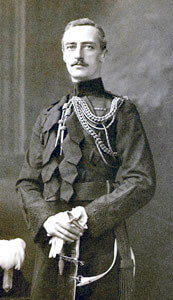
Lieutenant-Colonel the Hon. George Morris of the Irish Guards, killed at the Battle of Villers Cottérêts on 1st September 1914 in the First World War
2nd Grenadiers and 3rd Coldstream withdrew down the north-south road through the middle of the forest, passing through the Irish Guards and 2nd Coldstream, halting at Le Rond de la Reine, the crossing point for the road and the main west-east ride through the forest. The Grenadiers took up positions on the south side of the ride, to the east of the ‘Rond’ while the 3rd Coldstream occupied equivalent positions to the west of the rond.
At around 10am, Morris’s 2 battalions on the northern edge of the Retz Forest were threatened by a German force of cavalry, infantry and guns advancing from the north-west. This was the advance force of the German III Corps.
The British Foot Guards battalions were supported by 9th Battery RFA, firing from positions in a ride in the forest. The German advance came to a halt, and Morris, in compliance with the division’s orders, directed 2nd Coldstream and 9th Battery to withdraw down one of the north-south rides to the railway line to the north of Villers Cottérêts. The 2nd Coldstream took one of the rides leading south from their position, leading them directly to the railway line north of Villers Cottérêts, about 3 ½ miles.
After the Coldstream moved off and before the Irish Guards began their withdrawal through the Forest, Morris received orders from the brigade commander to maintain his position, as the rest of 2nd Division were being given a long halt until 1pm, to recover from the rigours of the previous days’ marches. The Irish Guards prepared to hold their positions.
At around 10am the regiments of the German 5th and 6th Divisions (III Corps) began their attack on the 4th Brigade positions. The German advance was obliquely from the north-west, and struck the Irish Guards’ positions, and penetrated through the forest to the western end of the 3rd Coldstream’s positions, along the central ride, at around the same time.
Heavy and confused fighting took place through the woods, as the Irish Guards fell back to the area of the Rond de La Reine. It was while leading his battalion in this fighting that Colonel Morris was killed.
3rd Coldstream realised that the German infantry was heading to pass their left flank, and extended their line along the east-west ride to cover more of the north-south rides. Brigadier-General Scott-Kerr attempted to move the whole brigade further to the left, but the German attack came on too quickly for any controlled move. The Grenadiers were soon engaged as the Irish Guards fell back on their positions.
The retreating parties of Irish Guards joined the main brigade line, as and where they arrived, so that the regiments became heavily intermingled. Officers took control of the men in their area, regardless of cap badge; a process eased by the close relationship between Brigade of Guards battalions.
Heavy exchanges of fire took place over short ranges along the rides and in the woods, with hand to hand fighting. A German machine gun took position in the east-west ride firing down the ride, causing casualties.
At a critical point in the battle, Brigadier-General Scott-Kerr was severely wounded. The brigade major ensured that the brigadier was safely evacuated. The absence of both the brigadier-general and the brigade major at the height of the battle created difficulties. Lieutenant-Colonel Cory of the 2nd Grenadiers took command of the brigade and Major Jeffreys the battalion, although he did so on his own initiative and without explicit orders. It would be hard to fault Jeffreys’ positive and decisive handling of the battalion during the rest of the battle and the next few days.
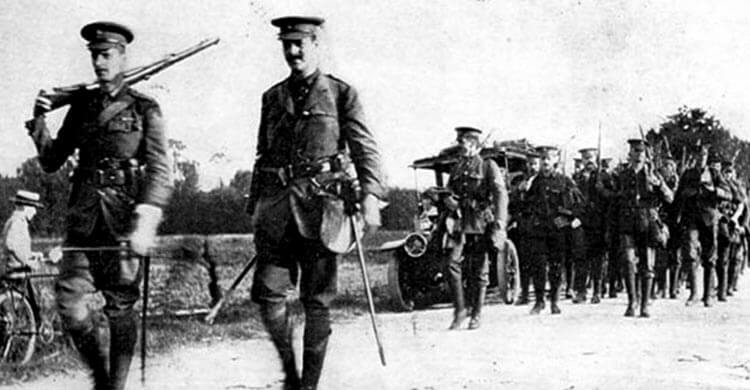
Lieutenant Colonel Corry leading 2nd Grenadier Guards in France in August 1914: Battle of Villers Cottérêts on 1st September 1914 in the First World War
At the beginning of the attack, it was reported that the Scots Greys and 12th Lancers, from 5th Cavalry Brigade, moved from east to west, through the centre of the woods, to the left of 4th Brigade. It is not clear whether these 2 regiments took any active part in the fighting.
In the rear, Major-General Munro, GOC of 2nd Division, organised support to enable 4th Brigade to retreat through Villers Cottérêts.
The 6th Brigade (1st King’s, 2nd South Staffs, 1st Royal Berkshires and 1st KRRC) was to the south of the town. 9th Battery RFA had fallen back to a position to the north of the town, on the edge of the forest, firing in support of the Guards and protected by companies of 2nd Royal Berkshire Regiment. 2nd Coldstream was deployed to the area of the Villers Cottérêts railway halt. The remaining 3 battalions of 6th Brigade were brought through the town to the northern side, to support the withdrawal of 4th Brigade from the forest.
The fighting, along the ride at the Rond de la Reine, and as the 3 Guards battalions fell back from the ride towards Villers Cottérêts, was extremely confused. 2 platoons of 2nd Grenadiers, commanded by Lieutenants Manners and Needham, were ordered by the GOC of the brigade to intercept an outflanking threat by German infantry down one of the rides. These 2 platoons were cut off and fought it out until all the officers and men were killed or disabled. Lieutenant Manners was killed and Lieutenant Needham wounded and captured.
By the time the 3 Guards battalions fought their way clear of the south of the Retz Forest, the German attack was in considerable confusion, German units roaming the woods and firing on each other, subject to the punishing gunfire from 9th and 17th Batteries.
The battalions of 4th Brigade marched through Villers Cottérêts, with 2nd Coldstream as the rear guard. As the brigade left the town, heading south, it was halted. The 2 RFA batteries were having difficulty bringing up teams to extract the guns, due to heavy German gun and small arms fire. 2nd Coldstream was ordered back through the town, to assist in extricating the batteries. In the event they were not needed. The German units were in such confusion, after the fighting in the forest that their attack was not pressed. The batteries were extracted with only the loss of a limber and few casualties.
6th Brigade, with the guns, followed 4th Brigade through Villers Cottérêts and headed south, bringing the battle to an end.
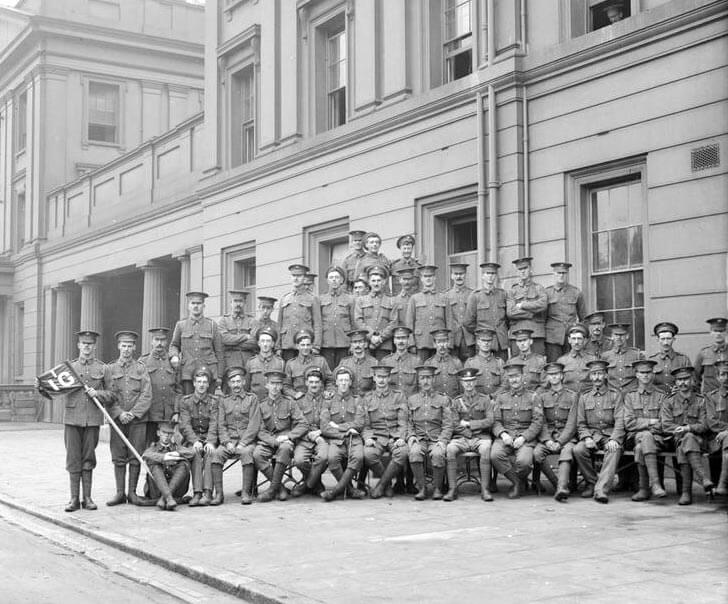
Lieutenant Alexander (in the Second World War, Earl Alexander of Tunis) with No 1 Platoon, 1st Irish Guards, at Wellington Barracks in August 1914: Battle of Villers Cottérêts on 1st September 1914 in the First World War
Casualties at the Battle of Villers Cottérêts:
4th Hussars: 1 officer killed and an unknown number of officers and soldiers killed, wounded and missing (dead or captured).
2nd Grenadiers: 2 officers killed, 2 officers missing: 2 soldiers wounded and 147 soldiers missing (dead or captured).
2nd Coldstream: no casualties.
3rd Coldstream: 1 officer killed, 2 officers missing: 7 soldiers killed, 16 soldiers wounded and 14 soldiers missing (dead or captured)
1st Irish Guards: 2 officers killed, 5 officers wounded: 4 soldiers killed, 36 soldiers wounded and 64 soldiers missing (dead or captured).
All the battalions in 6th Brigade suffered casualties as did 9th Battery. The total casualties in 2nd Division on 1st September 1914 were 20 officers and 471 soldiers killed, wounded or missing. Among these, Brigadier-General Scott-Kerr, the 4th brigade commander, was severely wounded.
German casualties are unknown, but British soldiers captured by the Germans, and released by the French later in the month, reported that the Germans suffered heavy casualties in the day’s fighting in the Retz Forest.
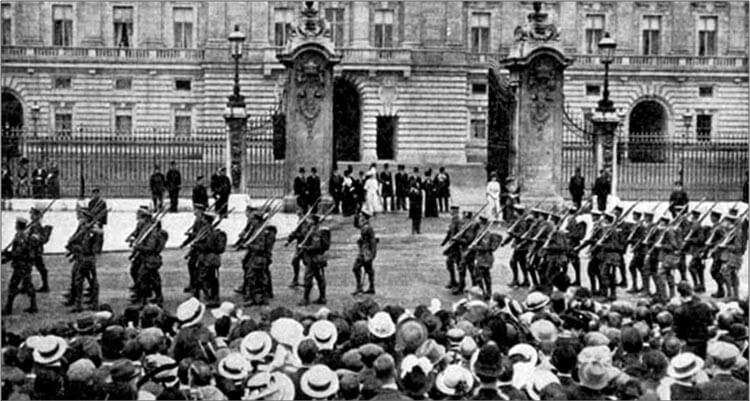
2nd Grenadier Guards, returning from a routine rout march, march past King George V outside Buckingham Palace in London, in August 1914 before leaving for France. The event was not arranged in advance. On being informed that the battalion was about to pass the palace, the King and Queen went out to the gates to watch: Battle of Villers Cottérêts on 1st September 1914 in the First World War
Aftermath to the Battle of Villers Cottérêts:
The BEF’s retreat was approaching its end, but it was still an arduous undertaking for the soldiers. 2nd Grenadiers and 2nd Coldstream took the wrong road during the evening of 1st September, causing them to march away from the brigade supply point. Major Jeffreys, in a vigorous display of initiative, sought out the divisional commander, Major-General Munro, and pointed out the parlous state of his soldiers after the day’s fighting. Munro directed that the battalion be supplied from another dump, ensuring that the Grenadiers received their evening meal. 2nd Coldstream were not so lucky and spent the night lying in the streets, unfed.
Decorations and campaign medals for the Battle of Villers Cottérêts:
See this entry under the Battle of Mons.
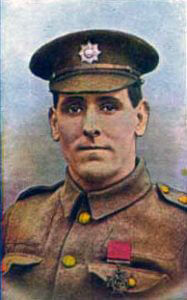
Lance Corporal GH Wyatt, 3rd Coldstream Guards, who won the Victoria Cross for bravery at Landrecies and at the Battle of Villers Cottérêts on 1st September 1914 in the First World War
Anecdotes and traditions from the Battle of Villers Cottérêts:
- Lance Corporal GH Wyatt of 3rd Coldstream Guards received his Victoria Cross primarily for his conduct in putting out the burning hay stack at Landrecies on 25th August 1914. The commendation also relied upon his conduct at Villers Cottérêts. Wyatt was wounded in the head, received treatment, and returned to the firing line.
- The Regimental Medical Officer of 2nd Coldstream Guards, Captain Sinclair RAMC, left his battalion at the Villers Cottérêts Halte to assist with the large number of casualties in the other battalions fighting in the forest. In the course of this duty, Captain Sinclair was captured by the Germans. After the battle the Germans established a hospital in Villers Cottérêts, to hold the wounded British prisoners. Captain Sinclair worked in this hospital. Later in the month, when the French re-occupied Villers Cottérêts, the German army left, leaving the British wounded in the hospital to be released, along with Sinclair.
References for the Battle of Villers Cottérêts:
- Official History of the Great War Volume 1
- History of the 2nd Division 1914-1918 Volume 1 by Wyrall
- The Grenadier Guards in the Great War of 1914-1918 Volume 1 by Ponsonby
- The Coldstream Guards 1914-1918 Volume 1 by Ross of Bladensburg
- The Irish Guards in the Great War 1st Battalion by Kipling
The previous battle in the First World War is the Battle of Néry
The next battle in the First World War is the Battle of the Marne